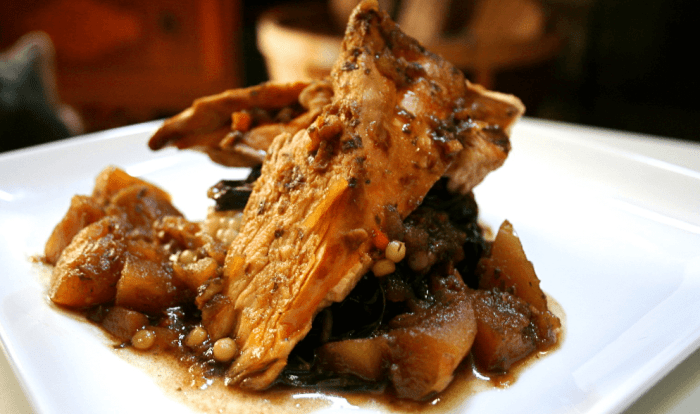
Embark on a culinary journey with the captivating Chicken of the Woods Recipe, a guide to discovering the unique flavors and versatility of this extraordinary mushroom.
From foraging tips to tantalizing recipes, this comprehensive guide unravels the secrets of Chicken of the Woods, offering a delightful fusion of culinary expertise and nature’s bounty.
Overview of Chicken of the Woods Mushroom

Chicken of the Woods, a fascinating and delectable mushroom, stands out with its unique appearance and culinary versatility. These mushrooms are distinguished by their vibrant orange to yellow hues, resembling the plumage of a chicken. They typically grow in clusters at the base of trees, particularly oaks, and are often found during the fall season.
Identification Features
Identifying Chicken of the Woods mushrooms involves observing their key characteristics. They typically feature a shelf-like shape with a wavy or lobed margin. The upper surface, known as the cap, displays a velvety texture and can range in size from a few inches to over a foot.
The underside, known as the pore surface, exhibits small, round pores that release spores for reproduction.
Habitat and Seasonality
Chicken of the Woods mushrooms thrive in moist, wooded areas, particularly near oak trees. They form a symbiotic relationship with the roots of these trees, exchanging nutrients and water. These mushrooms are predominantly found in the fall, typically from late summer to early winter, depending on the region and weather conditions.
Culinary Value
Chicken of the Woods mushrooms are highly prized for their culinary value. They possess a mild, savory flavor with a texture reminiscent of chicken, making them a versatile ingredient in various dishes. These mushrooms can be sautéed, roasted, or grilled, adding a unique umami flavor to soups, stews, pasta dishes, and more.
Looking for an alternative recipe for chicken of the woods? Try this one from Anoka Technical College here . This recipe features a creamy sauce made with white wine and Parmesan cheese, adding a touch of sophistication to the dish.
The detailed instructions and helpful tips ensure that even novice cooks can create a delicious and memorable meal.
Their versatility allows for creative culinary experimentation, making them a favorite among chefs and home cooks alike.
Preparation Techniques
Chicken of the Woods mushrooms are a versatile culinary ingredient that can be enjoyed in various forms. Before cooking, it’s essential to properly clean and handle the mushrooms to ensure their freshness and optimal flavor.
To clean Chicken of the Woods, gently brush off any dirt or debris from the surface using a soft brush or damp cloth. Avoid using water, as it can cause the mushrooms to absorb moisture and become soggy. Once cleaned, the mushrooms can be sliced or torn into desired shapes and sizes for cooking.
Craving a unique culinary experience? Check out this chicken of the woods recipe ! This wild mushroom, often found in late summer and fall, has a meaty texture and earthy flavor that’s perfect for grilling or sautéing. Whether you’re a seasoned forager or a curious culinary adventurer, this recipe will guide you through the process of preparing this delectable treat.
Cooking Techniques
Chicken of the Woods mushrooms offer a wide range of cooking possibilities, allowing you to experiment with different flavors and textures. Here are some popular cooking techniques for Chicken of the Woods:
- Sautéing:Sautéing involves cooking the mushrooms in a pan with a small amount of oil or butter over medium heat. This technique allows the mushrooms to develop a slightly crispy exterior while maintaining their tender interior.
- Grilling:Grilling is a great way to add smoky flavor to Chicken of the Woods. Brush the mushrooms with olive oil and grill them over medium heat for 5-7 minutes per side, or until tender and slightly charred.
- Roasting:Roasting Chicken of the Woods in the oven is a simple and flavorful method. Toss the mushrooms with olive oil, salt, and pepper, and roast them at 400°F (200°C) for 15-20 minutes, or until tender and browned.
- Stir-frying:Stir-frying Chicken of the Woods in a wok or large skillet is a quick and easy way to cook them. Heat some oil in the pan and stir-fry the mushrooms over high heat for 3-5 minutes, or until tender and slightly browned.
Preservation and Storage
To preserve the freshness of Chicken of the Woods mushrooms, store them in a paper bag or breathable container in the refrigerator for up to 5 days. You can also freeze the mushrooms for up to 6 months by blanching them in boiling water for 2 minutes before freezing.
Culinary Applications

Chicken of the Woods mushrooms are prized for their versatility in the kitchen. Their meaty texture and rich flavor make them a delicious addition to a wide range of dishes.
They can be cooked in various ways, including sautéing, roasting, grilling, and frying. Their robust flavor holds up well to bold seasonings and marinades, making them a perfect choice for hearty stews, soups, and curries.
Recipes
Here are a few recipes that showcase the versatility of Chicken of the Woods mushrooms:
| Ingredients | Cooking Method | Serving Suggestions |
|---|---|---|
| 1 pound Chicken of the Woods mushrooms, sliced | Sautéed in butter and garlic | As a side dish or over pasta |
| 1 pound Chicken of the Woods mushrooms, roasted with olive oil, salt, and pepper | Roasted at 400°F for 20 minutes | As a side dish or in salads |
| 1 pound Chicken of the Woods mushrooms, grilled with barbecue sauce | Grilled over medium heat for 10 minutes per side | As a main course or in sandwiches |
| 1 pound Chicken of the Woods mushrooms, fried in a tempura batter | Fried at 375°F for 2 minutes | As an appetizer or snack |
Flavor Profiles and Textures, Chicken of the woods recipe
Chicken of the Woods mushrooms have a unique flavor profile that is often described as earthy, nutty, and slightly sweet. The texture of the mushroom is meaty and tender, making it a satisfying substitute for chicken in many dishes.
The flavor and texture of Chicken of the Woods mushrooms can vary depending on the species and the growing conditions. Younger mushrooms tend to have a milder flavor and more tender texture, while older mushrooms may have a stronger flavor and tougher texture.
Health Benefits and Nutritional Value
Chicken of the Woods mushrooms are a nutritional powerhouse, boasting a rich composition of vitamins, minerals, and antioxidants. Consuming these mushrooms has been linked to various health benefits, including antioxidant protection, immune system support, and potential anti-cancer properties.
Nutritional Composition
A 100-gram serving of Chicken of the Woods mushrooms provides:
- Calories: 38
- Carbohydrates: 8 grams
- Protein: 3 grams
- Fiber: 2 grams
- Vitamin C: 14% of the recommended daily intake (RDI)
- Potassium: 12% of the RDI
- Phosphorus: 10% of the RDI
- Magnesium: 6% of the RDI
- Zinc: 5% of the RDI
- Selenium: 4% of the RDI
These nutrients play crucial roles in various bodily functions, including energy production, nerve function, and immune system health.
Antioxidant Properties
Chicken of the Woods mushrooms are rich in antioxidants, particularly ergothioneine and glutathione. Ergothioneine is a unique antioxidant that protects cells from damage caused by free radicals. Glutathione, on the other hand, helps neutralize toxins and supports liver function.
Immune System Support
The polysaccharides present in Chicken of the Woods mushrooms have been shown to stimulate the immune system and enhance its ability to fight infections. They activate immune cells, such as macrophages and natural killer cells, which help identify and destroy pathogens.
Foraging Considerations: Chicken Of The Woods Recipe
Responsible foraging practices are essential when harvesting Chicken of the Woods mushrooms to ensure the preservation of the species and prevent any harm to the environment. Identifying edible species and distinguishing them from poisonous look-alikes is crucial, as is understanding the legal and ethical implications of foraging in different regions.
Common Look-alikes
- Jack-o’-Lantern Mushrooms (Omphalotus illudens):These toxic mushrooms have orange caps and gills, resembling Chicken of the Woods but emit a faint fishy odor when cut.
- False Chanterelles (Hygrophoropsis aurantiaca):These mushrooms have bright orange caps but lack the distinctive teeth-like structures found on the underside of Chicken of the Woods.
Tips for Identification
- Examine the mushroom’s underside. Chicken of the Woods has tooth-like gills, while poisonous look-alikes typically have smooth or wavy gills.
- Check the mushroom’s flesh. Chicken of the Woods has white, firm flesh, while poisonous look-alikes may have yellow or reddish flesh.
- Consider the mushroom’s habitat. Chicken of the Woods grows on the trunks or stumps of oak trees, while poisonous look-alikes may be found on the ground or on other tree species.
Legal and Ethical Considerations
Foraging laws vary by region. In some areas, it is illegal to forage on public lands without a permit. It is essential to research the regulations in your area before foraging. Additionally, it is important to practice ethical foraging by harvesting only what you need and leaving the remaining mushrooms for others to enjoy.
Final Review

As you delve into the world of Chicken of the Woods, may this recipe collection inspire your culinary creativity and deepen your appreciation for the wonders of the forest. Let the vibrant flavors and textures of this remarkable mushroom ignite your taste buds and enrich your culinary repertoire.
Quick FAQs
What are the key characteristics of Chicken of the Woods mushrooms?
Chicken of the Woods mushrooms are known for their vibrant orange color, shelf-like shape, and unique texture that resembles chicken meat.
How can I identify edible Chicken of the Woods mushrooms?
Look for mushrooms with a bright orange color, a firm texture, and a white or cream-colored underside. Avoid mushrooms that are slimy, have a foul odor, or exhibit any signs of bruising.
What are the different ways to cook Chicken of the Woods mushrooms?
Chicken of the Woods mushrooms can be sautéed, grilled, roasted, or stir-fried. They can also be used in soups, stews, and casseroles.





